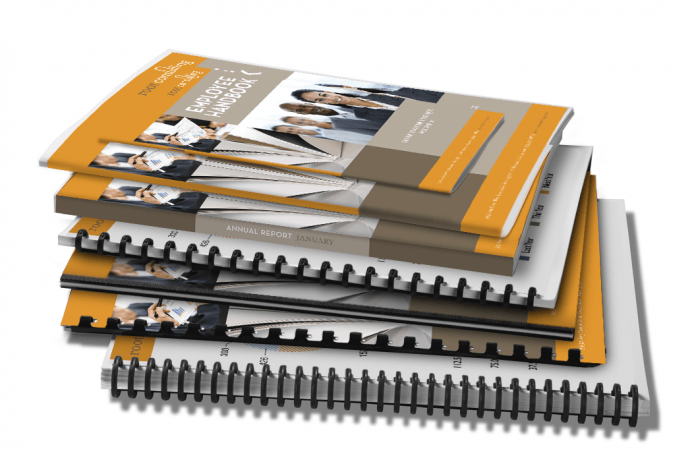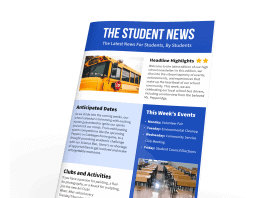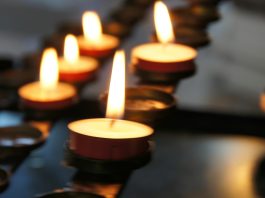Last updated on August 8th, 2024 at 01:15 pm
Binding plays a key role in the appearance and performance of a printed booklet. Selecting the best type of binding for a specific print project requires taking into account several factors, such as the function of the booklet, the number of pages, the desired quality of presentation, and your printing budget. But what are the various types of binding for booklets? Printivity specializes in four types of booklet binding options designed to meet your booklet printing needs. Whether you’re a company looking to give your print marketing materials a boost or a first-time author looking into book binding options, Printivity has the perfect binding style for you.
Infographic: How To Choose The Best Booklet Binding

1. Saddle stitch booklet printing

Saddle-stitching is one the most common and economical binding methods available for today’s printed booklets. The process works by folding sheets of paper together and stapling them through the fold line of the booklet. Two staples are used for booklets up to 64 pages.
Why is it called saddle-stitching if the pages are stapled instead of sewn? During the binding process, the folded sheets are draped over an apparatus that looks like a saddle. Early on, this process was given the name “saddle-stitching,” and it has become a staple in printing industry terminology ever since. Today, any bookbinding process that attaches wire staples through sheets of paper is commonly referred to as saddle-stitching.
Because saddle-stitching uses folded pages, the total page count for the booklet must be a multiple of four. This is important to keep in mind when designing and laying out your booklet. Otherwise, you might end up with one or more blank pages. The folding process also determines the size of the paper needed for the booklet. For example, if you want a standard page size of 8.5″ x 11 booklet, you would use 11″ x 17″ sheets of paper to accommodate the fold.
Saddle Stitch Book Printing are ideal for presenting articles, advertising, or news, such as:
- Programs
- Wall calendars
- Newsletters
- Pamphlets
- Direct mailers
- Comic books
- Thin magazines and catalogs
The saddle-stitching is one of he most very cost-effective binding options for booklets. This makes it ideal for short run print projects, one-time events (such as a race or fund-raiser), and other booklets that don’t need a long life span. It works best for binding booklets with 64 pages or less, as those with a higher page count may not lie as flat as you want.
Another advantage of saddle-stitching is its ability to work with a variety of paper types and finishes. This makes it possible to give your booklet a classy, professional look despite the low binding costs.
One point to remember: don’t place any text or graphics too close to the fold of the book’s spine or near an edge that will be trimmed. Otherwise, you may inadvertently cut off part of the content of the booklet.
2. Spiral binding booklet printing

Spiral binding is another popular binding option. It offers a wide array of print applications and is especially popular with business professionals for its simple design and ability to cost-effectively “dress up” small print projects of only a few pages.
Also known as coil binding, spiral binding holds the cover and the pages together using a plastic coil shaped like a long spring. The coil is threaded through evenly spaced holes punched into the spinal edge of the cover and pages. Once fully inserted, both ends of the coil are crimped to keep it from unraveling.
The plastic coils can be custom ordered in dozens of colors to coordinate with the cover, with black being the most popular. They also come in many different diameters to handle the number of pages in the booklet. The more pages in the book, the larger the diameter.
Spiral binding works well with pocket-sized books, oversized books and everything in between. The plastic binding allows for portrait or landscape paging and can even have the binding coil on top of the book instead of the side. This is a popular format for businesses and common applications range from instruction manuals, cookbooks, and directories to travel guides, PowerPoint presentations, textbooks, and calendars.
The primary advantages of this booklet binding option include:
- Can open 360 degrees and fold flat
- Pages are easy to turn
- An economical choice for short production runs
- The durable plastic coils resist distortion
- Great for wall calendars and other booklets that hang flat against a wall
- Can accommodate index tabs
- Quick turnaround times because no adhesives are needed
3. Wire-o booklet printing

The Wire Bound Book Printing option provides an upscale yet durable way to bind a wide variety of booklets ranging from presentations, reports, and workbooks to catalogs, cookbooks and more. The technique for this popular binding method is similar to spiral coil binding. However, instead of one continuous coil that runs the vertical length of the page, each coil is separate from the others, filling up two punched holes at a time.
Wire-o binding allows books to lay flat when open and to fold pages around to the back of the booklet. The wire loops are made of sturdy wire and can be custom ordered in a variety of colors that can coordinate with the color and design of the cover if desired. The features that make Wire-o so popular include:
Pages can open to a full 360 degrees. A Wire-o bound booklet can remain flat when folding pages backward. This allows the reader to focus on one page at a time and takes up a smaller amount of room on a crowded desktop or table. It also makes the booklet easier to handle when traveling, which is one reason the Wire-o binding option is often used with map booklets and travel guides. The 360-degree opening also eliminates the possibility of information getting buried close to the booklet’s spine.
Pages are easy to turn. The size and shape of the wire loops create minimal resistance when turning a page. More importantly, Wire-o booklets have no spinal tension, which means the pages stay in place after being turned. Unlike a paperback novel, you don’t have to hold the pages apart to keep the booklet from closing upon itself. This feature is well-suited for journals and workbooks that involve working or writing on the page.
The binding can handle high and low page count books. Wire-o loops come in a wide variety of diameters to accommodate books of all sizes. A book with more pages will use a larger loop and thicker wire gauge. Thinner books will use a smaller size wire. As long as the right size loop is used, even high page count books can lay flat and offer the same ease of page turning.
The binding can accommodate index tabs. The ability of Wire-o bound booklets to stay open by themselves allows problem-free use of page taps. This is one reason why Wire-o binding is often used with reference documents such as reports, directories, and training manuals, so readers can quickly find specific information without having to flip through the pages.
Works well with thick paper stocks. The unique design of the wires makes Wire-o binding well suited for booklets that require thicker paper stocks. It is also good for manuals and workbooks that receive a lot of rough treatment during their lifespan.
The time to use this booklet binding option is when:
- You want to customize the look and feel of your booklet with different papers, covers, and coating options
- Want a book that can easily lay flat
- Want a neater, more organized look than spiral binding
- Need the booklet to make a polished, professional presentation
- Need a sturdy, durable binding that can take more than the average use
4. Perfect bound book printing

Perfect Bound Book Printing is another popular method with one big difference from the three booklet binding options listed above – it uses an adhesive rather than wires or coils to hold the book together. A strong yet pliable adhesive is applied to the spine to bind the cover and pages together. Then they are cut to the exact same size to produce a perfect edge on all three sides.
This booklet binding option is far and away the leading choice for soft cover books, especially paperbacks. The cover usually consists of a heavier stock of paper than the other pages, and a clear coating can be added at an additional cost for more durability and improved visual appeal. Perfect binding is also very popular in the business world because it combines cost-effective binding with a very professional look and feel. Common business applications include corporate reports, catalogs, product brochures, manuals, and magazines.
Benefits of perfect binding include:
- High-quality presentation
- Cost less to produce than hardcover books
- Very strong, durable spine
- The square spine allows for printing on the spine
- Spine will not crack or break in extreme high or low temperatures
- Is suitable for short runs
5. PUR Perfect Bound Book

As stated above, perfect bound books are considered the most professional soft cover book option on the market. From the clean cuts for the perfect edge on all three sides to the only spine that allows for printing, perfect bound books are the go-to binding option for magazines and catalogs. There is only one way to improve this product, and that is to make it stronger to increase its shelf life. The simplest way to do this is by using a stronger adhesive that is 50% stronger than EVA, which is the industry standard glue.
The structure of perfect bound books creates a common problem that doesn’t allow these books to lay flat when opened. Instead, there is a curve of the pages coming from the spine away from the surface that it is resting on. With the flexible properties of PUR glue, the PUR perfect bound books are able to be opened wide and pressed down without the possibility of the glue cracking at the spine. In a page-pull test, PUR proved to have a 50% stronger hold than the traditional EVA adhesive. Due to the strong bond, less glue is required to be applied which makes it more flexible and creates less distortion of the spine. Ultimately, PUR allows for an even cleaner appearance than the traditional adhesive.
Upgrade your perfect bound book to PUR when you need your product to withstand time. If you create a book that with the intention of it being used for a short period of time, decide whether the more cost effective option of traditional EVA glue perfect bound books is the better choice. However, if you intend for your book to be frequently used or have a high page count, choose PUR perfect bound books for the added strength and durability.
- Thin coat of adhesive allows for a more flexible spine and cleaner appearance
- Lay-flat abilities – can be pushed down without the spine cracking
- 50% stronger adhesive than EVA perfect bound books
- Ideal for high page count books
6. Hardcover Books

Hardcover books are the product of a process called case binding, and are the most premium book binding option in the industry. Every element of these books are designed for durability and quality. Once your custom cover design is printed and protected by lamination of your choosing, they are glued to a heavy-duty chip board. The book block, which ranges from 30-400 page documents, is attached to the hardcover spine using the strongest glue on the market.
There are unique properties to hardcover books that you will not find in other book binding options. The one that stands out the most are the endsheets. This sheet is glued to the inside of the front and back cover to cover the chip board and gives a smooth appearance. The endsheet extends past the cover and is the first and last sheet of your book. The extended part of the sheet is commonly referred to as the flyleaf. Setting up your content will be different compared to other book types due to the flyleaf. Most booklets allow printing on the inside cover, but unfortunately printing is not available on the endsheet/flyleaf. Because of this, you will need to start designing your content to start on the right side.
7. Three Ring Binders
Three-ring binders are one of the newest binding offerings at Printivity. Binders offer two different products that, when combined, create an infinitely interchangeable binding option that includes three-ring binders and binder documents.
All three ring binder offerings hold 8.5″ x 11″ documents, but you can choose different spine thicknesses, depending on how much you need it to hold. The spine thicknesses offered are 0.5″, 1.0″, 1.5″, 2.0″, and 3.0″. You can also choose to print custom front and back covers and a spine to match your brand and purpose of the binder, which are showcased in the clearview pockets.

Printivity’s binder documents let you choose between black-and-white and color copies. A three-hole punch is included to easily add to your binder. Add divider tabs to your order when you want to find the exact section as fast as possible. These divider tabs extend 0.5″ past the other documents to quickly thumb through the sections.
Benefits
Other unique features of hardcover books either will protect, extend the time of use, or guarantee a personalized book! As previously mentioned, every hardcover book includes laminated covers. Lamination protects your covers from scratches and other damages that are expected from constant handling. Choose from two finishes that will boost the design of your covers: matte or gloss. The velvet appearance of matte lamination eliminates light reflection. Gloss laminations give your cover extra shine and make the colors in your design pop!
PUR glue is used to bind hardcover books which adds to their premium quality. The flexible features of PUR off lay-flat properties without the glue cracking. PUR glue is also 50% stronger than the standard glue used for binding, known as EVA glue. The extra strength of this glue makes it the ideal choice for large page count books or books that will be frequently used.
The sturdiness of the chip board allows the book to stand on its own, which is why this binding type is always on bookshelves. The thickness of the chipboard also guarantees that the spine will be wide enough for personalized printing. Most spine designs include: the author’s name, volume #, and, most importantly, the book title.
Hardcover books can be used for any of your book printing needs. Here some ideas that they can be used for:
- Cookbooks
- Yearbooks
- Coffee Table books
- Textbooks
- Photobooks
If you still have questions…
When you need a professionally bound booklet, bring it to the experts at Printivity. Request an instant cost estimate with our online booklet printing price quoter to get started on your next project. Or, call us at 877-649-5463 with any questions.
Infographic: How To Choose The Best Book Binding





